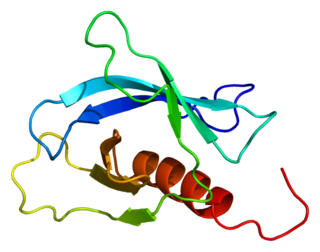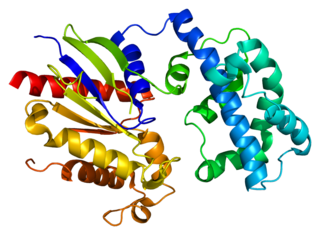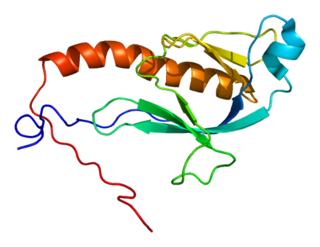
Guanine nucleotide exchange factors (GEFs) are proteins or protein domains that activate monomeric GTPases by stimulating the release of guanosine diphosphate (GDP) to allow binding of guanosine triphosphate (GTP). A variety of unrelated structural domains have been shown to exhibit guanine nucleotide exchange activity. Some GEFs can activate multiple GTPases while others are specific to a single GTPase.
The Rho family of GTPases is a family of small signaling G proteins, and is a subfamily of the Ras superfamily. The members of the Rho GTPase family have been shown to regulate many aspects of intracellular actin dynamics, and are found in all eukaryotic kingdoms, including yeasts and some plants. Three members of the family have been studied in detail: Cdc42, Rac1, and RhoA. All G proteins are "molecular switches", and Rho proteins play a role in organelle development, cytoskeletal dynamics, cell movement, and other common cellular functions.

Cell division control protein 42 homolog is a protein that in humans is encoded by the CDC42 gene. Cdc42 is involved in regulation of the cell cycle. It was originally identified in S. cerevisiae (yeast) as a mediator of cell division, and is now known to influence a variety of signaling events and cellular processes in a variety of organisms from yeast to mammals.
FYVE, RhoGEF and PH domain containing (FGD) is a gene family consisting of:

Rho guanine nucleotide exchange factor 1 is a protein that in humans is encoded by the ARHGEF1 gene. This protein is also called RhoGEF1 or p115-RhoGEF.

Rho guanine nucleotide exchange factor 11 is a protein that in humans is encoded by the ARHGEF11 gene. This protein is also called RhoGEF11 or PDZ-RhoGEF.

Rho guanine nucleotide exchange factor 12 is a protein that in humans is encoded by the ARHGEF12 gene. This protein is also called RhoGEF12 or Leukemia-associated Rho guanine nucleotide exchange factor (LARG).

RhoG is a small monomeric GTP-binding protein, and is an important component of many intracellular signalling pathways. It is a member of the Rac subfamily of the Rho family of small G proteins and is encoded by the gene RHOG.

Dedicator of cytokinesis protein (Dock7) is a large protein encoded in the human by the DOCK7 gene, involved in intracellular signalling networks. It is a member of the DOCK-C subfamily of the DOCK family of guanine nucleotide exchange factors (GEFs) which function as activators of small G-proteins. Dock7 activates isoforms of the small G protein Rac.
Rac is a subfamily of the Rho family of GTPases, small signaling G proteins. Just as other G proteins, Rac acts as a molecular switch, remaining inactive while bound to guanosine diphosphate (GDP) and activated once guanine nucleotide exchange factors (GEFs) remove GDP, permitting guanosine triphosphate (GTP) to bind. When bound to GTP, Rac is activated. In its activated state, Rac participates in the regulation of cell movement, through its involvement in structural changes to the actin cytoskeleton. By changing the cytoskeletal dynamics within the cell, Rac-GTPases are able to facilitate the recruitment of neutrophils to the infected tissues, and to regulate degranulation of azurophil and integrin-dependent phagocytosis.

FYVE, RhoGEF and PH domain-containing protein 3 is a protein that in humans is encoded by the FGD3 gene.

Dedicator of cytokinesis protein 4 (Dock4), is a large protein encoded in the human by the DOCK4 gene, involved in intracellular signalling networks. It is a member of the DOCK-B subfamily of the DOCK family of guanine nucleotide exchange factors (GEFs) which function as activators of small G-proteins. Dock4 activates the small G proteins Rac and Rap1.

FYVE, RhoGEF and PH domain-containing protein 4 is a protein encoded in humans by the FGD4 gene.

Guanine nucleotide-binding protein subunit alpha-13 is a protein that in humans is encoded by the GNA13 gene.

Dedicator of cytokinesis protein 9 (Dock9), also known as Zizimin1, is a large protein encoded in the human by the DOCK9 gene, involved in intracellular signalling networks. It is a member of the DOCK-D subfamily of the DOCK family of guanine nucleotide exchange factors that function as activators of small G-proteins. Dock9 activates the small G protein Cdc42.

Dedicator of cytokinesis protein 6 (Dock6), also known as Zir1 is a large protein encoded in the human by the DOCK6 gene, involved in intracellular signalling networks. It is a member of the DOCK-C subfamily of the DOCK family of guanine nucleotide exchange factors which function as activators of small G-proteins.

Dedicator of cytokinesis protein 11 (Dock11), also known as Zizimin2, is a large protein encoded in the human by the DOCK11 gene, involved in intracellular signalling networks. It is a member of the DOCK-D subfamily of the DOCK family of guanine nucleotide exchange factors (GEFs) which function as activators of small G-proteins. Dock11 activates the small G protein Cdc42.

FYVE, RhoGEF and PH domain-containing protein 2 (FGD2), also known as zinc finger FYVE domain-containing protein 4 (ZFYVE4), is a protein that in humans is encoded by the FGD2 gene.

The Rho GTPase activating protein 31 is encoded in humans by the ARHGAP31 gene. It is a Cdc42/Rac1 GTPase regulator.

Pleckstrin homology domain containing, family G member 2 (PLEKHG2) is a protein that in humans is encoded by the PLEKHG2 gene. It is sometimes written as ARHGEF42, FLJ00018.




















